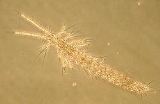
Mystacocarida
Encyclopedia
Mystacocarida is a subclass of crustacean
s, that form part of the meiobenthos
. They are less than 1 mm (0.0393700787401575 in) long, and live interstitially in the intertidal zone
s of sandy beaches.
divided between two genera
, Derocheilocaris (8 species) and Ctenocheilocharis (5 species). The first mystacocarids to be found were discovered on a beach on southern New England
in 1939.
and five abdominal
segments. There are four pairs of small thoracic appendages.
The head is relatively large and divided into two by a stricture, so that the latter part gives the appearance of being a part of the thorax. This region bears a pair of maxillipeds, and the head also has two pairs of maxilla
e, a pair of limb-like mandible
s, and two pairs of long antenna
e. The appendages on the head are much longer than those on the thorax, and have a number of fine hairs that the animal uses to strain detritus from the water to feed on. They have a single naupliar eye. After mating, mystacocarids lay tiny eggs which hatch into a nauplius or metanauplius
larva.
Crustacean
Crustaceans form a very large group of arthropods, usually treated as a subphylum, which includes such familiar animals as crabs, lobsters, crayfish, shrimp, krill and barnacles. The 50,000 described species range in size from Stygotantulus stocki at , to the Japanese spider crab with a leg span...
s, that form part of the meiobenthos
Meiobenthos
Meiofauna are small benthic invertebrates that live in both marine and fresh water environments . The term Meiofauna loosely defines a group of organisms by their size, larger than Microfauna but smaller than Macrofauna, rather than a taxonomic grouping...
. They are less than 1 mm (0.0393700787401575 in) long, and live interstitially in the intertidal zone
Intertidal zone
The intertidal zone is the area that is above water at low tide and under water at high tide . This area can include many different types of habitats, with many types of animals like starfish, sea urchins, and some species of coral...
s of sandy beaches.
Taxonomy
The taxonomy of Mystacocarida is extremely conservative, since all mystacocarids look superficially alike. , there are 13 described speciesSpecies
In biology, a species is one of the basic units of biological classification and a taxonomic rank. A species is often defined as a group of organisms capable of interbreeding and producing fertile offspring. While in many cases this definition is adequate, more precise or differing measures are...
divided between two genera
Genus
In biology, a genus is a low-level taxonomic rank used in the biological classification of living and fossil organisms, which is an example of definition by genus and differentia...
, Derocheilocaris (8 species) and Ctenocheilocharis (5 species). The first mystacocarids to be found were discovered on a beach on southern New England
New England
New England is a region in the northeastern corner of the United States consisting of the six states of Maine, New Hampshire, Vermont, Massachusetts, Rhode Island, and Connecticut...
in 1939.
Distribution
Mystacocarids occur along the coasts of South and North America, southern Africa, and the western Mediterranean. The lack of records from other parts of the world are "almost certainly" due to a lack of appropriate sampling, rather than a true absence.Decsription
Mystacocarids are tiny crustaceans, less than 1 millimetre (0.0393700787401575 in) long, that live in the spaces between sand grains on intertidal beaches. They have a cylindrical body, with five thoracicThorax
The thorax is a division of an animal's body that lies between the head and the abdomen.-In tetrapods:...
and five abdominal
Abdomen
In vertebrates such as mammals the abdomen constitutes the part of the body between the thorax and pelvis. The region enclosed by the abdomen is termed the abdominal cavity...
segments. There are four pairs of small thoracic appendages.
The head is relatively large and divided into two by a stricture, so that the latter part gives the appearance of being a part of the thorax. This region bears a pair of maxillipeds, and the head also has two pairs of maxilla
Maxilla
The maxilla is a fusion of two bones along the palatal fissure that form the upper jaw. This is similar to the mandible , which is also a fusion of two halves at the mental symphysis. Sometimes The maxilla (plural: maxillae) is a fusion of two bones along the palatal fissure that form the upper...
e, a pair of limb-like mandible
Mandible (arthropod)
thumb|250px|The mandibles of a [[Bull ant]]The mandible of an arthropod is either of a pair of mouthparts used for biting, cutting and holding food. Mandibles are often simply referred to as jaws. Mandibles are present in the extant subphyla Myriapoda , Crustacea and Hexapoda...
s, and two pairs of long antenna
Antenna (biology)
Antennae in biology have historically been paired appendages used for sensing in arthropods. More recently, the term has also been applied to cilium structures present in most cell types of eukaryotes....
e. The appendages on the head are much longer than those on the thorax, and have a number of fine hairs that the animal uses to strain detritus from the water to feed on. They have a single naupliar eye. After mating, mystacocarids lay tiny eggs which hatch into a nauplius or metanauplius
Metanauplius
Metanauplius is an early larval stage of some crustaceans such as krill. It follows the nauplius stage.In sac-spawning krill, there is an intermediary phase called pseudometanauplius, a newly hatched form distinguished from older metanauplii by its extremely short abdomen...
larva.

